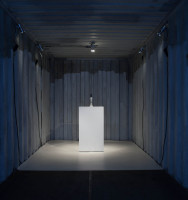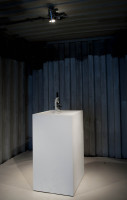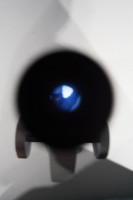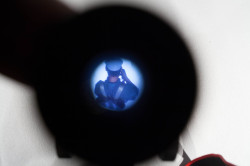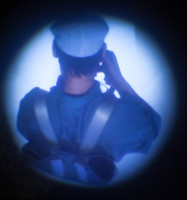Videoinstallation 2012
On a platform on a white ground, a microscope is placed, how it used to know from school. A spotlight illuminates the structure from above. The visitor is invited to approach the podium and look through the microscope. He sees first a vague, dark shape on a white background. If the viewer moves, the shape moves with a slight delay under the microscope. As soon as his point of view using the rotary wheel focus, he sees through the microscope himself: a captured video image from above, which shows himself bent over the microscope watching this image.
The image of the camera that films the viewer from above, is projected onto a screen in real time at screen in the podium. Using different lenses will shrink the video so much that it is half a square millimeter in size – it could so easily be projected on a rice grain. This extremely small projection can the observer now see looking through the microscope at a magnification of 60 times. The result is a so-called ‚closed circuit‘, a closed image situation where the medium of film recording and reproduction are directly connected to each other.
The generated simultaneity between reality and image can be associated with other media art works based on this operation. An early example is provided by the Argentine artist Marta Minujín in 1967 with her work „Short Circuit“. Especially prominent is the installation„TV Buddha“ by Nam June Paik in 1974, in which a Buddha figure is sitting in the exhibition space and watching himself on television, over the television is clearly visible a camera that films the motionless Buddha from the front. This recording will be broadcast live on the TV.
If the viewer stands behind the Buddha, he is also visible in the video image. Again, the image will be generated in real time, and translates the situation in the exhibition space into a digital mirror image.
„White Cube Closed Circuit“ creates a closed – circuit – situation. At the end the viewer – regardless of the exhibition space where the installation will be shown – will see himself in a white cube: Due to the white surface on which the platform, mounted with the microscope is standing, receives the captured image from the top movie a white background, of which sets it apart from just the viewer bent over the microscope. Thus, the viewer looks through the microscope from above into a small white space. The result is an exhibition space in the exhibition space. This allows the viewer to watch now even from the air while watching. The viewer is therefore an object of contemplation. He is an exhibit. The white background produces not only a classic white- cube exhibition situation, but also represents an analogy to the scientific use of the microscope, in which a product is always examined against a white background.
The viewer of Peter Weibel‘s installation “Beobachtung der Beobachtung: Unbestimmtheit” (1973) is a performer who moves between cameras and monitors, as far as the installation setup allows it – can see themselves in a real exhibition space.„White Cube Closed Circuit“ leads to an almost motionless image of a new space which is created by the piece itself. While there is also moving images but it shows the largely motionless, lost in thought attitude which requires the use of a microscope, and the more similar to a photo. So in the installation „White Cube closed-circuit“ the consideration of the consideration or exploration of the research is brought about as a situation and issued. The white cube seen through the microscope does not include art, but the reflection of art: It makes the process of viewing and the white cube as a condition of viewing an object of contemplation and reflection.
(text: Judith Rottenburg /translation Max Engelhardt)
